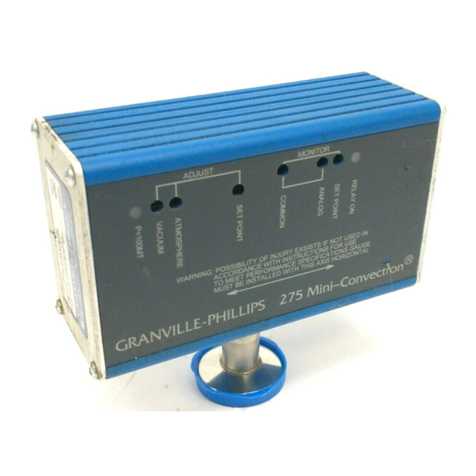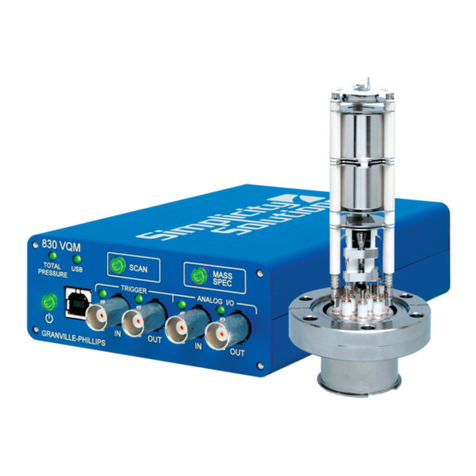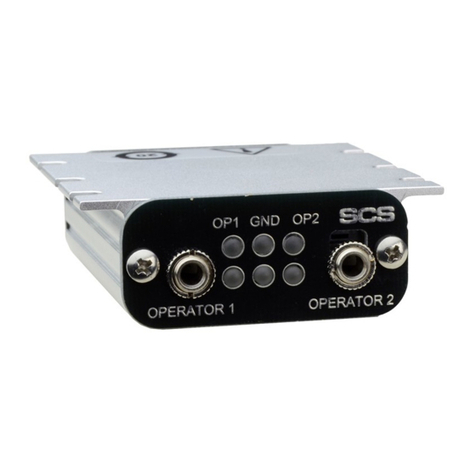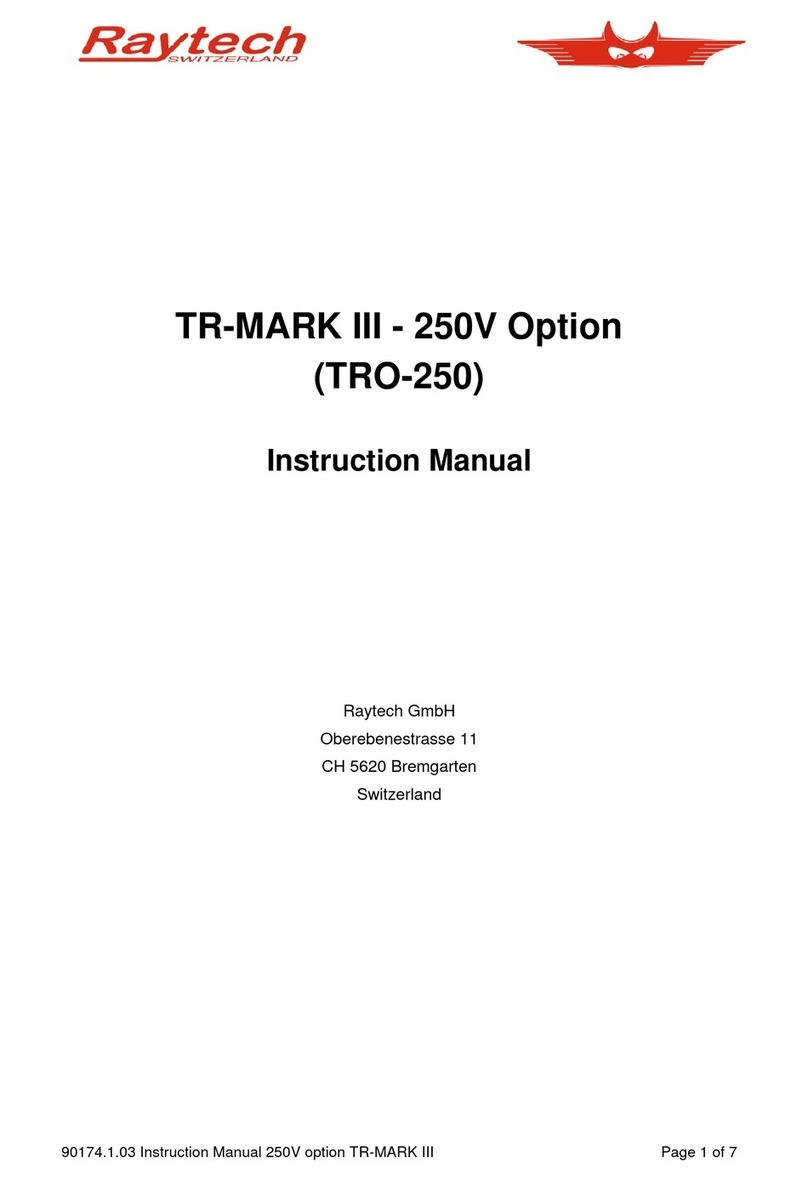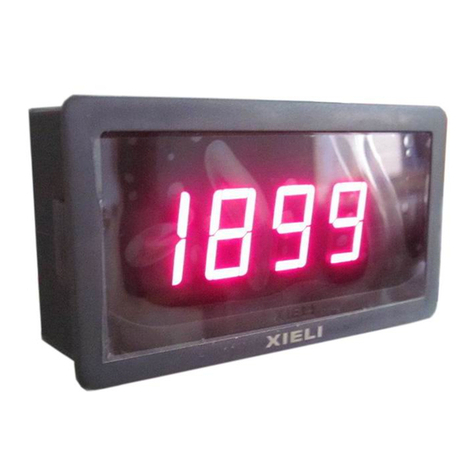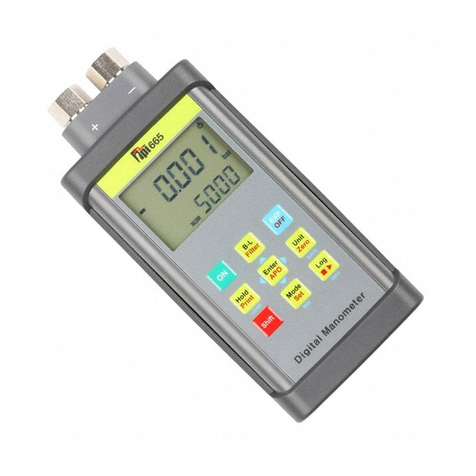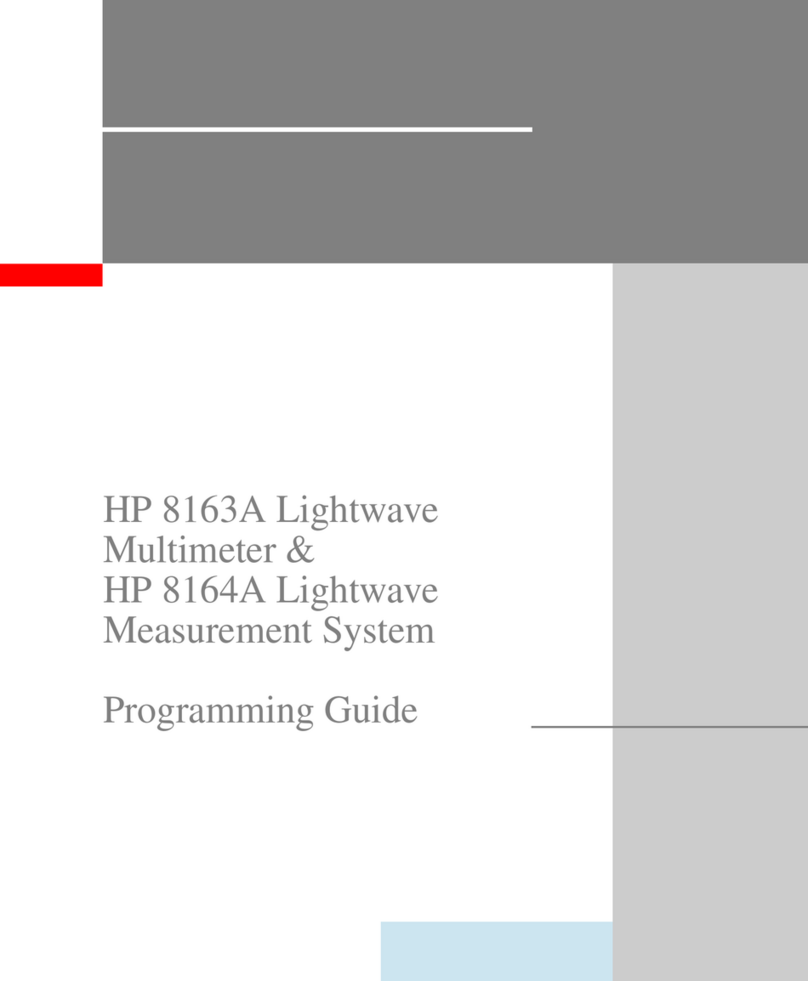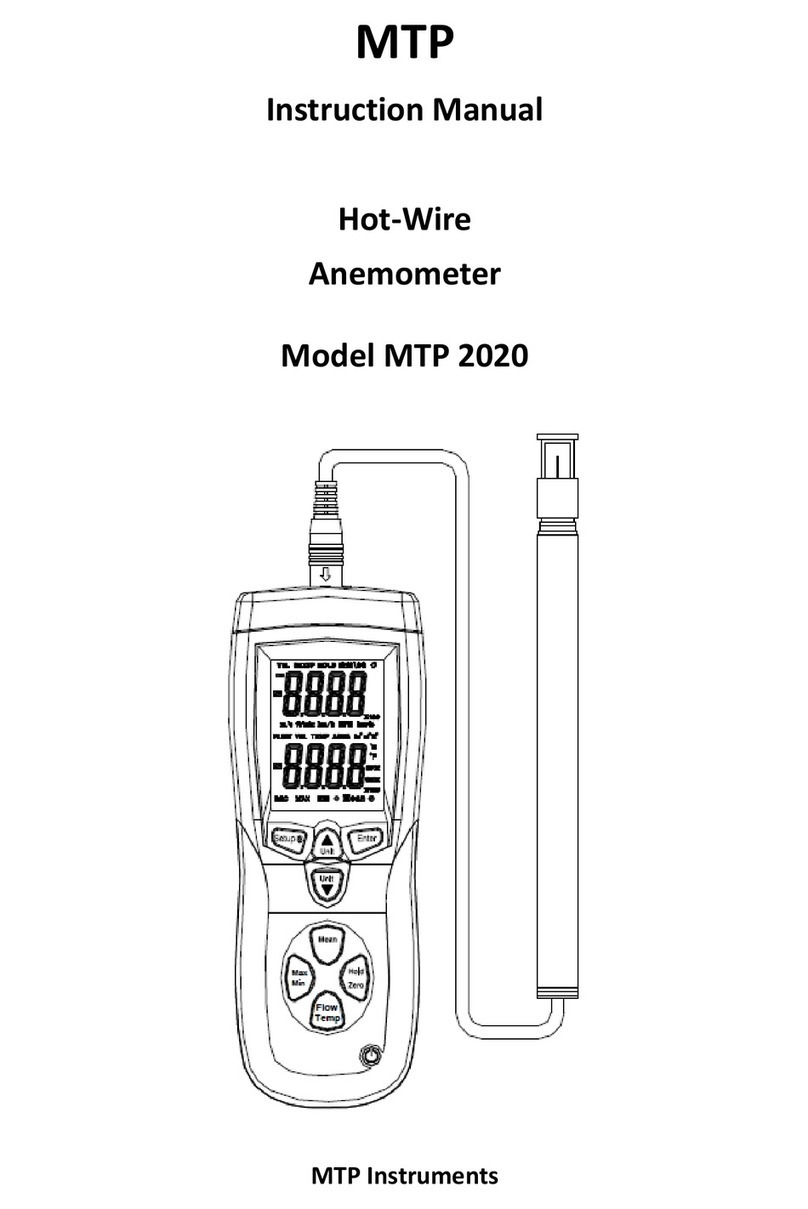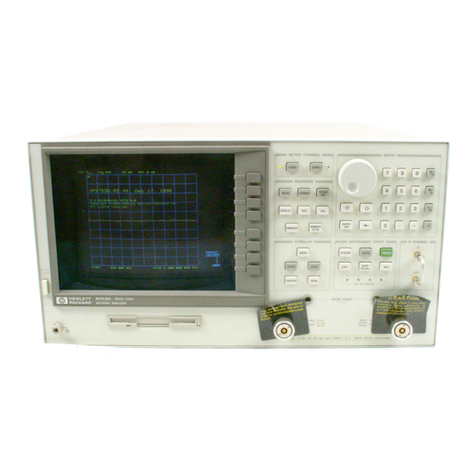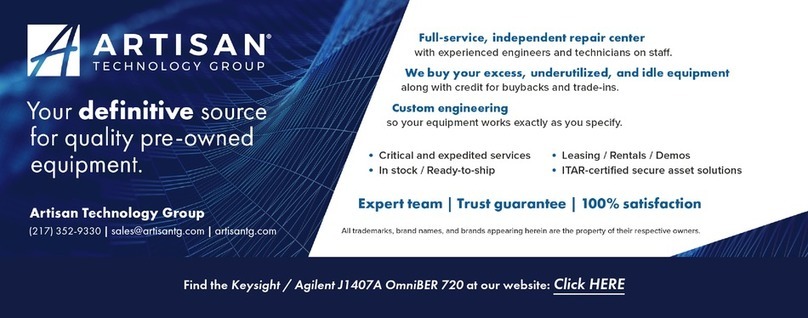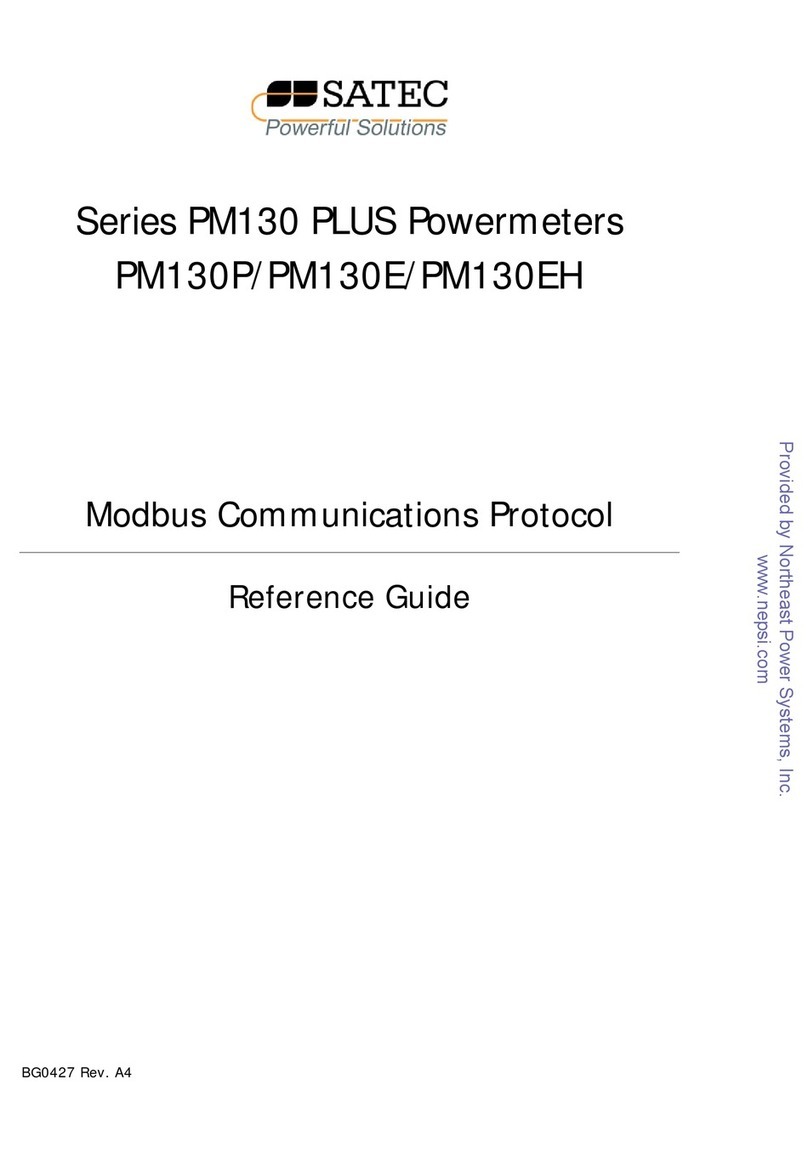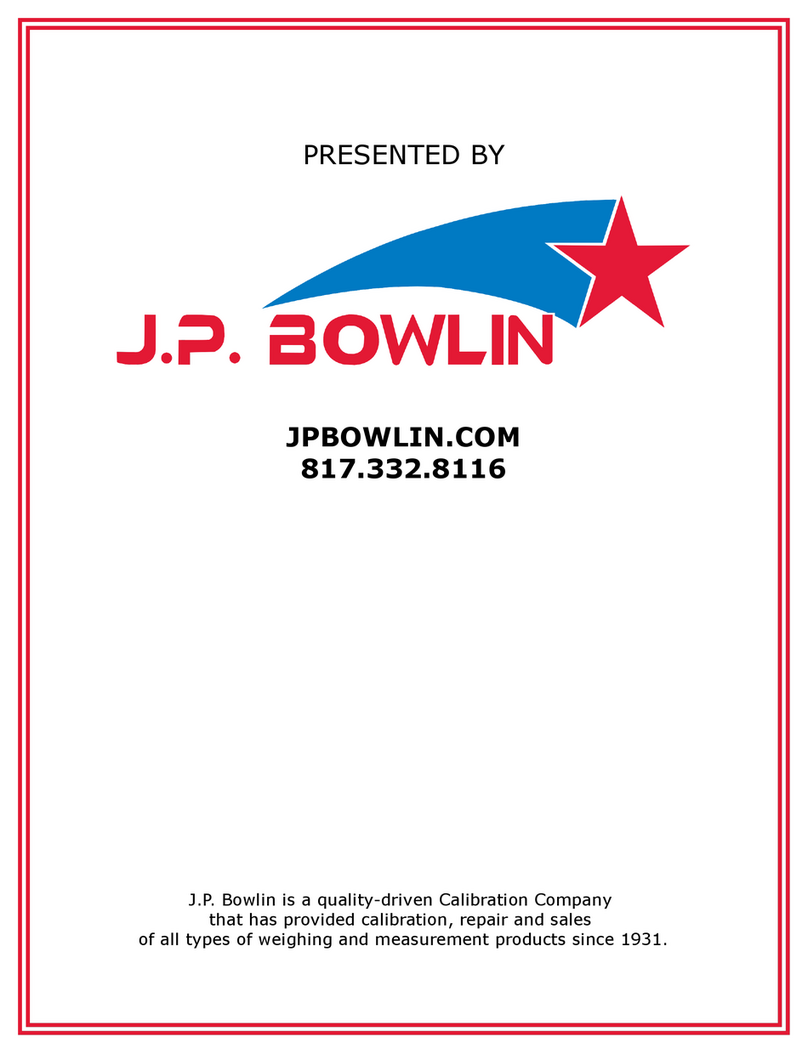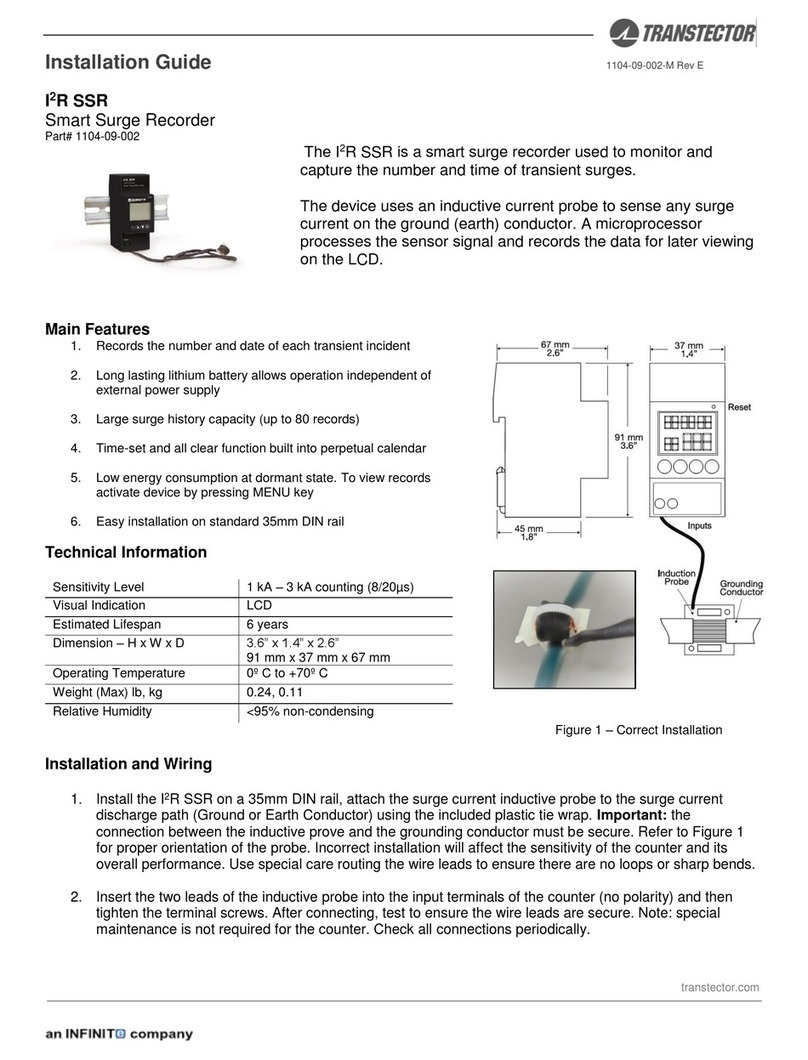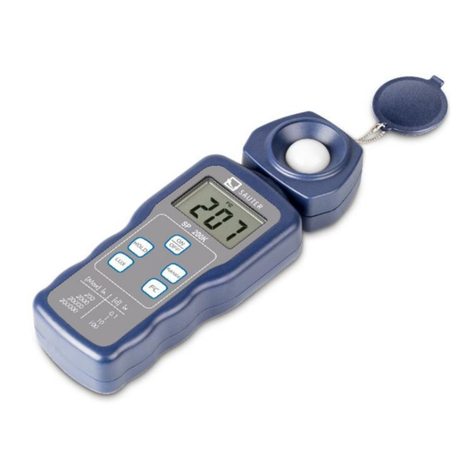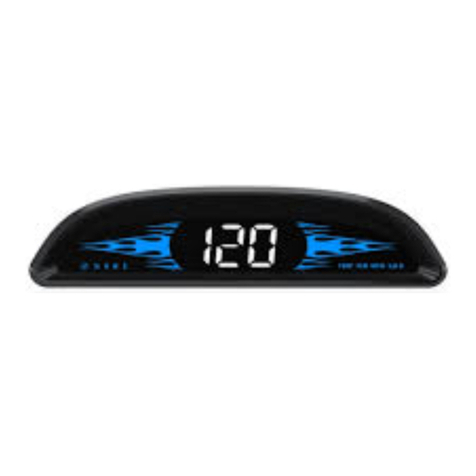Granville-Phillips 358 Series Manual

Series 358
1Granville-Phillips Micro-Ion®
Vacuum Measurement System
Installation, Operation, and Maintenance Instructions
Instruction Manual Catalog No. 358013-07
This manual is for use only with the following catalog numbers:
The “#” symbol represents a variable in the catalog number.
See Section 1.6, Catalog Number Configurations on page 1-12.
For assistance in using or servicing this instrument contact:
Helix Technology Corporation
Colorado Operations
Customer Service Department
6450 Dry Creek Pkwy
Longmont, Colorado 80503-9501 USA
Telephone (303) 652-4400
FAX (303) 652-2844
email: salesco@helixtechnology.com
Granville-Phillips, Micro-Ion, and Convectron are registered trademarks of Helix Technology Corporation.
358501-###-## 358502-###-## 358503-###-## 20358024-T1 358506-T2
358001 358002 358003 358004 358035
358006 358007 20358018 20358023
20358024 20358028 20358029 20358031
© Copyright Helix Technology Corporation 1996-2002
Revised: June 2002
All Rights Reserved
GRANVILLE-PHILLIPS
HELIX TECHNOLOGY CORPORATION

Declaration of Conformity
In accordance with ISO/IEC Guide 22 and EN45014
The undersigned declares that the products specified above conform to the checked Directive(s) and Standard(s)
when installed in accordance with the manufacturer’s specifications.
Larry K. Carmichael
Director of Engineering
Date: 08/27/02
Helix Document Number 014119-103
Product Name(s): Granville - Phillips Series 360/370 Stabil-Ion®Vacuum Gauge Controllers
Product Number(s): 360101 360102 360187 360188 20360136
370101 370102 20360150 20360174 20360175
20360182 20360184 20360185 20370134 20370135
360###-###-## 370###-###-## 370505-010-T1 370505-A10-T1
The “#” symbol represents a variable in the part number.
Option(s):
Conformance to
Directive(s):
ýEMC Directive
89/336/EEC COUNCIL DIRECTIVE of 03 May 1989 on the approximation of the laws of
the Member States relating to electromagnetic compatibility.
ýLow-Voltage Directive
73/23/EEC COUNCIL DIRECTIVE of 19 February 1973 on the harmonization of the laws
of the Member States relating to electrical equipment designed for use within certain
voltage limits. Amended by 93/68/EEC.
Applicable
Standard(s):
EMC Directive
ýEN 50081-2: EMC Generic Emission Standard, Part 2: Industrial Environment, 1994
EN 50082-2: EMC Generic Immunity Standard, Part 2: Industrial Environment, 1995.
¨EN 61326: Electrical Equipment for Measurement, Control and Laboratory Use - EMC
Requirements, 1997. Emissions: Class A. Immunity: Annex A - Immunity Test
Requirements for Equipment Intended for Use in Industrial Locations.
Low-Voltage Directive
ýEN 61010-1: Safety Requirements for Electrical Equipment for Measurement, Control,
and Laboratory Use, Part 1: General Requirements, 1993; A2, 1995.

i
Series 358 Micro-Ion Vacuum Measurement System November, 2001
Table of Contents
Safety. . . . . . . . . . . . . . . . . . . . . . . . . . . . . . . . . . . . . . . . . . . . . . . . . . . . . . . . . . . . . . . . . . . . . . . . . . . . . . . . . . . . . . v
Safety Instructions . . . . . . . . . . . . . . . . . . . . . . . . . . . . . . . . . . . . . . . . . . . . . . . . . . . . . . . . . . . . . . . . . . . . . . . . v
Certification. . . . . . . . . . . . . . . . . . . . . . . . . . . . . . . . . . . . . . . . . . . . . . . . . . . . . . . . . . . . . . . . . . . . . . . . . . . . ix
Warranty Information . . . . . . . . . . . . . . . . . . . . . . . . . . . . . . . . . . . . . . . . . . . . . . . . . . . . . . . . . . . . . . . . . . . . ix
Service Guidelines . . . . . . . . . . . . . . . . . . . . . . . . . . . . . . . . . . . . . . . . . . . . . . . . . . . . . . . . . . . . . . . . . . . . . . . ix
FCC Verification . . . . . . . . . . . . . . . . . . . . . . . . . . . . . . . . . . . . . . . . . . . . . . . . . . . . . . . . . . . . . . . . . . . . . . . . ix
Chapter 1 System Components . . . . . . . . . . . . . . . . . . . . . . . . . . . . . . . . . . . . . . . . . . . . . . . . . . . . . . . . . . . . . . . 1-1
1.1 System Components . . . . . . . . . . . . . . . . . . . . . . . . . . . . . . . . . . . . . . . . . . . . . . . . . . . . . . . . . . . . . . . . 1-1
1.2 Controller Front Panel . . . . . . . . . . . . . . . . . . . . . . . . . . . . . . . . . . . . . . . . . . . . . . . . . . . . . . . . . . . . . . . 1-2
1.2.1 Controls Inside Front Panel . . . . . . . . . . . . . . . . . . . . . . . . . . . . . . . . . . . . . . . . . . . . . . . . . . . . . 1-3
1.2.2 Top View of Controller (Cover Removed) . . . . . . . . . . . . . . . . . . . . . . . . . . . . . . . . . . . . . . . . . . 1-4
1.3 Options . . . . . . . . . . . . . . . . . . . . . . . . . . . . . . . . . . . . . . . . . . . . . . . . . . . . . . . . . . . . . . . . . . . . . . . . . . 1-5
1.3.1 Process Control Relay. . . . . . . . . . . . . . . . . . . . . . . . . . . . . . . . . . . . . . . . . . . . . . . . . . . . . . . . . . 1-5
1.3.2 RS-232 or RS-485/422 Computer Interface Module . . . . . . . . . . . . . . . . . . . . . . . . . . . . . . . . . . 1-5
1.3.2.1 Rear Panel with RS-232 Option . . . . . . . . . . . . . . . . . . . . . . . . . . . . . . . . . . . . . . . . . . . 1-5
1.3.2.2 RS-232 Specifications . . . . . . . . . . . . . . . . . . . . . . . . . . . . . . . . . . . . . . . . . . . . . . . . . . . 1-6
1.3.2.3 RS-485 Specifications . . . . . . . . . . . . . . . . . . . . . . . . . . . . . . . . . . . . . . . . . . . . . . . . . . . 1-6
1.3.3 Power On/Off . . . . . . . . . . . . . . . . . . . . . . . . . . . . . . . . . . . . . . . . . . . . . . . . . . . . . . . . . . . . . . . 1-7
1.3.4 Remote Input/Output . . . . . . . . . . . . . . . . . . . . . . . . . . . . . . . . . . . . . . . . . . . . . . . . . . . . . . . . . 1-7
1.3.5 IG Cables. . . . . . . . . . . . . . . . . . . . . . . . . . . . . . . . . . . . . . . . . . . . . . . . . . . . . . . . . . . . . . . . . . . 1-7
1.3.6 Mounting Options. . . . . . . . . . . . . . . . . . . . . . . . . . . . . . . . . . . . . . . . . . . . . . . . . . . . . . . . . . . . 1-7
1.4 System Specifications . . . . . . . . . . . . . . . . . . . . . . . . . . . . . . . . . . . . . . . . . . . . . . . . . . . . . . . . . . . . . . . . 1-8
1.5 Dimensions . . . . . . . . . . . . . . . . . . . . . . . . . . . . . . . . . . . . . . . . . . . . . . . . . . . . . . . . . . . . . . . . . . . . . . 1-10
1.5.1 358 Controller . . . . . . . . . . . . . . . . . . . . . . . . . . . . . . . . . . . . . . . . . . . . . . . . . . . . . . . . . . . . . . 1-10
1.5.2 Micro-Ion Gauge with Connector . . . . . . . . . . . . . . . . . . . . . . . . . . . . . . . . . . . . . . . . . . . . . . . 1-11
1.5.3 Convectron Gauge with Connector . . . . . . . . . . . . . . . . . . . . . . . . . . . . . . . . . . . . . . . . . . . . . . 1-11
1.5.4 Fittings. . . . . . . . . . . . . . . . . . . . . . . . . . . . . . . . . . . . . . . . . . . . . . . . . . . . . . . . . . . . . . . . . . . . 1-11
1.6 Catalog Number Configurations . . . . . . . . . . . . . . . . . . . . . . . . . . . . . . . . . . . . . . . . . . . . . . . . . . . . . . 1-12
Chapter 2 Initial Setup Procedures . . . . . . . . . . . . . . . . . . . . . . . . . . . . . . . . . . . . . . . . . . . . . . . . . . . . . . . . . . . . . 2-1
2.1 Controller Setup . . . . . . . . . . . . . . . . . . . . . . . . . . . . . . . . . . . . . . . . . . . . . . . . . . . . . . . . . . . . . . . . . . . 2-1
2.1.1 Top Cover Removal . . . . . . . . . . . . . . . . . . . . . . . . . . . . . . . . . . . . . . . . . . . . . . . . . . . . . . . . . . 2-1
2.2 Pressure Units Setup . . . . . . . . . . . . . . . . . . . . . . . . . . . . . . . . . . . . . . . . . . . . . . . . . . . . . . . . . . . . . . . . 2-2
2.2.1 Changing Units of Measure for the Electrometer Module . . . . . . . . . . . . . . . . . . . . . . . . . . . . . . 2-2
2.2.1.1 Overpressure Shutdown Adjustment . . . . . . . . . . . . . . . . . . . . . . . . . . . . . . . . . . . . . . . 2-3
2.2.1.2 Changing the Display Update Rate on Electrometer Module . . . . . . . . . . . . . . . . . . . . . 2-3
2.2.2 Changing Units of Measure for the Convectron Gauge . . . . . . . . . . . . . . . . . . . . . . . . . . . . . . . . 2-4
2.2.2.1 Display Update Rate Switch on Convectron Module . . . . . . . . . . . . . . . . . . . . . . . . . . . 2-4
2.3 Process Control Setup . . . . . . . . . . . . . . . . . . . . . . . . . . . . . . . . . . . . . . . . . . . . . . . . . . . . . . . . . . . . . . . 2-4
2.3.1 Process Control Channel Identification Windows . . . . . . . . . . . . . . . . . . . . . . . . . . . . . . . . . . . . 2-5
2.3.2 Developing a Logic Diagram of Control Logic. . . . . . . . . . . . . . . . . . . . . . . . . . . . . . . . . . . . . . . 2-5
2.3.3 Ion Gauge Assignment for Process Control. . . . . . . . . . . . . . . . . . . . . . . . . . . . . . . . . . . . . . . . . . 2-7
2.3.4 Relay Polarity Setting . . . . . . . . . . . . . . . . . . . . . . . . . . . . . . . . . . . . . . . . . . . . . . . . . . . . . . . . . . 2-8
2.3.5 Process Control Tips . . . . . . . . . . . . . . . . . . . . . . . . . . . . . . . . . . . . . . . . . . . . . . . . . . . . . . . . . . 2-9
2.4 RS-232 Computer Interface Setup . . . . . . . . . . . . . . . . . . . . . . . . . . . . . . . . . . . . . . . . . . . . . . . . . . . . . . 2-9
2.4.1 Connector Pinouts for the RS-232 Computer Interface . . . . . . . . . . . . . . . . . . . . . . . . . . . . . . . 2-10
2.4.2 Selecting the Byte Format for RS-232 Module. . . . . . . . . . . . . . . . . . . . . . . . . . . . . . . . . . . . . . 2-10
2.4.2.1 Baud Rate for RS-232 Module . . . . . . . . . . . . . . . . . . . . . . . . . . . . . . . . . . . . . . . . . . . 2-10
2.4.2.2 Character Framing for RS-232 Module . . . . . . . . . . . . . . . . . . . . . . . . . . . . . . . . . . . . 2-11
2.4.3 Talk-Only Mode for RS-232 Module. . . . . . . . . . . . . . . . . . . . . . . . . . . . . . . . . . . . . . . . . . . . . 2-11

Table of Contents
ii Series 358 Micro-Ion Vacuum Measurement System November, 2001
2.4.4 Handshake Line Control Switches for RS-232 Module . . . . . . . . . . . . . . . . . . . . . . . . . . . . . . . 2-12
2.4.5 Invert RTS Switch for RS-232 Module . . . . . . . . . . . . . . . . . . . . . . . . . . . . . . . . . . . . . . . . . . . 2-13
2.5 RS-485 Computer Interface Setup . . . . . . . . . . . . . . . . . . . . . . . . . . . . . . . . . . . . . . . . . . . . . . . . . . . . . 2-14
2.5.1 Connector Pinouts for the RS-485 Computer Interface . . . . . . . . . . . . . . . . . . . . . . . . . . . . . . . 2-14
2.5.2 RS-485 Address . . . . . . . . . . . . . . . . . . . . . . . . . . . . . . . . . . . . . . . . . . . . . . . . . . . . . . . . . . . . . 2-15
2.5.3 Selecting the Byte Format for RS-485 Module. . . . . . . . . . . . . . . . . . . . . . . . . . . . . . . . . . . . . . 2-16
2.5.3.1 Baud Rate for RS-485 . . . . . . . . . . . . . . . . . . . . . . . . . . . . . . . . . . . . . . . . . . . . . . . . . 2-16
2.5.3.2 Character Framing for the RS-485 Computer Interface . . . . . . . . . . . . . . . . . . . . . . . . 2-16
2.5.4 Response Delay for the RS-485 Computer Interface. . . . . . . . . . . . . . . . . . . . . . . . . . . . . . . . . . 2-16
2.6 Replacing Controller Cover . . . . . . . . . . . . . . . . . . . . . . . . . . . . . . . . . . . . . . . . . . . . . . . . . . . . . . . . . . 2-17
Chapter 3 Installation . . . . . . . . . . . . . . . . . . . . . . . . . . . . . . . . . . . . . . . . . . . . . . . . . . . . . . . . . . . . . . . . . . . . . . 3-1
3.1 Gauge Installation Tips . . . . . . . . . . . . . . . . . . . . . . . . . . . . . . . . . . . . . . . . . . . . . . . . . . . . . . . . . . . . . . 3-1
3.1.1 EMC Compliance . . . . . . . . . . . . . . . . . . . . . . . . . . . . . . . . . . . . . . . . . . . . . . . . . . . . . . . . . . . . 3-1
3.1.2 Cable Installation Statement. . . . . . . . . . . . . . . . . . . . . . . . . . . . . . . . . . . . . . . . . . . . . . . . . . . . . 3-1
3.1.3 Environmental Conditions. . . . . . . . . . . . . . . . . . . . . . . . . . . . . . . . . . . . . . . . . . . . . . . . . . . . . . 3-2
3.2 Controller Installation . . . . . . . . . . . . . . . . . . . . . . . . . . . . . . . . . . . . . . . . . . . . . . . . . . . . . . . . . . . . . . . 3-2
3.2.1 Installing the Controller . . . . . . . . . . . . . . . . . . . . . . . . . . . . . . . . . . . . . . . . . . . . . . . . . . . . . . . . 3-2
3.2.2 Installation Hardware Part Numbers . . . . . . . . . . . . . . . . . . . . . . . . . . . . . . . . . . . . . . . . . . . . . . 3-2
3.2.3 Mounting Configurations. . . . . . . . . . . . . . . . . . . . . . . . . . . . . . . . . . . . . . . . . . . . . . . . . . . . . . . 3-3
3.2.4 Line Voltage. . . . . . . . . . . . . . . . . . . . . . . . . . . . . . . . . . . . . . . . . . . . . . . . . . . . . . . . . . . . . . . . . 3-4
3.2.4.1 Fuse Replacement Instructions: . . . . . . . . . . . . . . . . . . . . . . . . . . . . . . . . . . . . . . . . . . . 3-4
3.3 Convectron Gauge Installation . . . . . . . . . . . . . . . . . . . . . . . . . . . . . . . . . . . . . . . . . . . . . . . . . . . . . . . . 3-5
3.3.1 Mounting Options. . . . . . . . . . . . . . . . . . . . . . . . . . . . . . . . . . . . . . . . . . . . . . . . . . . . . . . . . . . . 3-6
3.3.1.1 Compression Mount/Quick Connect . . . . . . . . . . . . . . . . . . . . . . . . . . . . . . . . . . . . . . . 3-6
3.3.1.2 1/8 NPT Mount . . . . . . . . . . . . . . . . . . . . . . . . . . . . . . . . . . . . . . . . . . . . . . . . . . . . . . . 3-6
3.3.1.3 VCR®/VCO®Mount . . . . . . . . . . . . . . . . . . . . . . . . . . . . . . . . . . . . . . . . . . . . . . . . . . 3-6
3.3.1.4 NW10KF, NW16KF, NW25KF and NW40KF Flange Mount . . . . . . . . . . . . . . . . . . . 3-6
3.3.1.5 ConFlat Flange Mount . . . . . . . . . . . . . . . . . . . . . . . . . . . . . . . . . . . . . . . . . . . . . . . . . . 3-6
3.4 Grounding the System . . . . . . . . . . . . . . . . . . . . . . . . . . . . . . . . . . . . . . . . . . . . . . . . . . . . . . . . . . . . . . . 3-7
3.4.1 System Ground Test Procedure . . . . . . . . . . . . . . . . . . . . . . . . . . . . . . . . . . . . . . . . . . . . . . . . . . 3-7
3.4.1.1 Procedure for Testing Grounding of Systems . . . . . . . . . . . . . . . . . . . . . . . . . . . . . . . . . 3-8
3.5 Connecting Analog Outputs . . . . . . . . . . . . . . . . . . . . . . . . . . . . . . . . . . . . . . . . . . . . . . . . . . . . . . . . . . 3-9
3.5.1 Electrometer Module Analog Output Signal. . . . . . . . . . . . . . . . . . . . . . . . . . . . . . . . . . . . . . . . . 3-9
3.5.2 Convectron Gauge Analog Output Signal . . . . . . . . . . . . . . . . . . . . . . . . . . . . . . . . . . . . . . . . . 3-10
3.6 Connecting Process Control Relays . . . . . . . . . . . . . . . . . . . . . . . . . . . . . . . . . . . . . . . . . . . . . . . . . . . . 3-11
3.7 Connecting the RS-232 Computer Interface . . . . . . . . . . . . . . . . . . . . . . . . . . . . . . . . . . . . . . . . . . . . . 3-12
3.7.1 RS-232 Command Summary. . . . . . . . . . . . . . . . . . . . . . . . . . . . . . . . . . . . . . . . . . . . . . . . . . . 3-12
3.7.2 Reversing the Polarity of RTS. . . . . . . . . . . . . . . . . . . . . . . . . . . . . . . . . . . . . . . . . . . . . . . . . . . 3-12
3.8 Connecting the RS-485 Computer Interface . . . . . . . . . . . . . . . . . . . . . . . . . . . . . . . . . . . . . . . . . . . . 3-13
Chapter 4 Preparing for Operation . . . . . . . . . . . . . . . . . . . . . . . . . . . . . . . . . . . . . . . . . . . . . . . . . . . . . . . . . . . . 4-1
4.1 Preparing for Pressure Measurement . . . . . . . . . . . . . . . . . . . . . . . . . . . . . . . . . . . . . . . . . . . . . . . . . . . . 4-1
4.1.1 Alternate ON/OFF Gauge Control . . . . . . . . . . . . . . . . . . . . . . . . . . . . . . . . . . . . . . . . . . . . . . . 4-2
4.2 Micro-Ion Analog Output Signal . . . . . . . . . . . . . . . . . . . . . . . . . . . . . . . . . . . . . . . . . . . . . . . . . . . . . . . 4-2
4.3 Preparing for Convectron Gauge Operation . . . . . . . . . . . . . . . . . . . . . . . . . . . . . . . . . . . . . . . . . . . . . . 4-3
4.3.1 Understanding Pressure Measurement in Gases other than Nitrogen (or Air). . . . . . . . . . . . . . . . 4-4
4.3.2 Examples . . . . . . . . . . . . . . . . . . . . . . . . . . . . . . . . . . . . . . . . . . . . . . . . . . . . . . . . . . . . . . . . . . . 4-6
4.4 Ionization Gauge Auto Turn On/Off . . . . . . . . . . . . . . . . . . . . . . . . . . . . . . . . . . . . . . . . . . . . . . . . . . 4-13
4.4.1 Filament Auto Turn-On. . . . . . . . . . . . . . . . . . . . . . . . . . . . . . . . . . . . . . . . . . . . . . . . . . . . . . . 4-13
4.5 Adjustment of Convectron Gauge Zero and Atmospheric Pressure Indications . . . . . . . . . . . . . . . . . . . 4-14
4.6 Convectron Gauge Analog Output Signal . . . . . . . . . . . . . . . . . . . . . . . . . . . . . . . . . . . . . . . . . . . . . . . 4-15
4.7 Preparing for Process Control Operation . . . . . . . . . . . . . . . . . . . . . . . . . . . . . . . . . . . . . . . . . . . . . . . . 4-16
4.7.1 Setpoint Display and Adjustment. . . . . . . . . . . . . . . . . . . . . . . . . . . . . . . . . . . . . . . . . . . . . . . . 4-16

Table of Contents
iii
Series 358 Micro-Ion Vacuum Measurement System November, 2001
4.7.2 Manual Override . . . . . . . . . . . . . . . . . . . . . . . . . . . . . . . . . . . . . . . . . . . . . . . . . . . . . . . . . . . . 4-16
4.7.3 To Display a Setpoint. . . . . . . . . . . . . . . . . . . . . . . . . . . . . . . . . . . . . . . . . . . . . . . . . . . . . . . . . 4-16
4.7.4 To Modify a Setpoint. . . . . . . . . . . . . . . . . . . . . . . . . . . . . . . . . . . . . . . . . . . . . . . . . . . . . . . . . 4-17
4.8 Preparing for Use of the RS-232 Computer Interface . . . . . . . . . . . . . . . . . . . . . . . . . . . . . . . . . . . . . . 4-17
4.8.1 Command Syntax for the RS-232 Computer Interface. . . . . . . . . . . . . . . . . . . . . . . . . . . . . . . . 4-17
4.9 Preparing for Use of the RS-485 Computer Interface . . . . . . . . . . . . . . . . . . . . . . . . . . . . . . . . . . . . . . 4-19
4.9.1 Command Syntax for the RS-485 Computer Interface. . . . . . . . . . . . . . . . . . . . . . . . . . . . . . . . 4-20
Chapter 5 Operation . . . . . . . . . . . . . . . . . . . . . . . . . . . . . . . . . . . . . . . . . . . . . . . . . . . . . . . . . . . . . . . . . . . . . . . 5-1
5.1 Operation of the Series 358 Micro-Ion Vacuum Measurement System . . . . . . . . . . . . . . . . . . . . . . . . . . 5-1
5.1.1 Turning On the Controller. . . . . . . . . . . . . . . . . . . . . . . . . . . . . . . . . . . . . . . . . . . . . . . . . . . . . . 5-1
5.1.2 Micro-Ion Gauge On/Off. . . . . . . . . . . . . . . . . . . . . . . . . . . . . . . . . . . . . . . . . . . . . . . . . . . . . . . 5-3
5.1.3 Degas On/Off . . . . . . . . . . . . . . . . . . . . . . . . . . . . . . . . . . . . . . . . . . . . . . . . . . . . . . . . . . . . . . . 5-3
5.1.4 Special Considerations for Convectron Gauge Use Below 10-3 Torr . . . . . . . . . . . . . . . . . . . . . . 5-3
5.2 Operation of Micro-Ion Gauge Electrometer Module . . . . . . . . . . . . . . . . . . . . . . . . . . . . . . . . . . . . . . . 5-4
5.2.1 Displaying Sensitivity with the Calibration Switch. . . . . . . . . . . . . . . . . . . . . . . . . . . . . . . . . . . . 5-4
5.2.2 Emission Range Switch. . . . . . . . . . . . . . . . . . . . . . . . . . . . . . . . . . . . . . . . . . . . . . . . . . . . . . . . . 5-4
5.2.3 Sensitivity Adjustment . . . . . . . . . . . . . . . . . . . . . . . . . . . . . . . . . . . . . . . . . . . . . . . . . . . . . . . . . 5-4
5.2.3.1 Relative Gas Sensitivities . . . . . . . . . . . . . . . . . . . . . . . . . . . . . . . . . . . . . . . . . . . . . . . . . 5-4
5.2.4 Filament Selection for the Micro-Ion Gauge Electrometer Module . . . . . . . . . . . . . . . . . . . . . . . 5-5
5.2.4.1 Filament Select Switch . . . . . . . . . . . . . . . . . . . . . . . . . . . . . . . . . . . . . . . . . . . . . . . . . . 5-5
5.3 Theory of Operation . . . . . . . . . . . . . . . . . . . . . . . . . . . . . . . . . . . . . . . . . . . . . . . . . . . . . . . . . . . . . . . . 5-6
5.3.1 Micro-Ion Gauge Theory of Operation . . . . . . . . . . . . . . . . . . . . . . . . . . . . . . . . . . . . . . . . . . . . 5-6
5.3.2 Convectron Gauge Theory of Operation . . . . . . . . . . . . . . . . . . . . . . . . . . . . . . . . . . . . . . . . . . . 5-7
5.3.3 Microcontrollers and Bus Structure . . . . . . . . . . . . . . . . . . . . . . . . . . . . . . . . . . . . . . . . . . . . . . . 5-7
5.3.4 Process Control Theory of Operation. . . . . . . . . . . . . . . . . . . . . . . . . . . . . . . . . . . . . . . . . . . . . . 5-8
5.3.4.1 Process Control Specifications . . . . . . . . . . . . . . . . . . . . . . . . . . . . . . . . . . . . . . . . . . . . 5-8
Chapter 6 Service and Maintenance . . . . . . . . . . . . . . . . . . . . . . . . . . . . . . . . . . . . . . . . . . . . . . . . . . . . . . . . . . . . 6-1
6.1 Service Guidelines . . . . . . . . . . . . . . . . . . . . . . . . . . . . . . . . . . . . . . . . . . . . . . . . . . . . . . . . . . . . . . . . . . 6-1
6.2 Damage Requiring Service . . . . . . . . . . . . . . . . . . . . . . . . . . . . . . . . . . . . . . . . . . . . . . . . . . . . . . . . . . . . 6-2
6.3 Overpressure Shutdown . . . . . . . . . . . . . . . . . . . . . . . . . . . . . . . . . . . . . . . . . . . . . . . . . . . . . . . . . . . . . . 6-4
6.4 Troubleshooting the Convectron Gauge Module . . . . . . . . . . . . . . . . . . . . . . . . . . . . . . . . . . . . . . . . . . . 6-5
6.4.1 Convectron Gauge Test Procedure. . . . . . . . . . . . . . . . . . . . . . . . . . . . . . . . . . . . . . . . . . . . . . . . 6-5
6.4.2 Cleaning Contaminated Convectron Gauges . . . . . . . . . . . . . . . . . . . . . . . . . . . . . . . . . . . . . . . . 6-6
6.5 Process Control Troubleshooting . . . . . . . . . . . . . . . . . . . . . . . . . . . . . . . . . . . . . . . . . . . . . . . . . . . . . . 6-6
6.6 RS-232 Troubleshooting . . . . . . . . . . . . . . . . . . . . . . . . . . . . . . . . . . . . . . . . . . . . . . . . . . . . . . . . . . . . . 6-7
6.7 RS-485 Troubleshooting . . . . . . . . . . . . . . . . . . . . . . . . . . . . . . . . . . . . . . . . . . . . . . . . . . . . . . . . . . . . . 6-8
6.8 Field Installation of Modules . . . . . . . . . . . . . . . . . . . . . . . . . . . . . . . . . . . . . . . . . . . . . . . . . . . . . . . . . . 6-9
6.9 Service Form . . . . . . . . . . . . . . . . . . . . . . . . . . . . . . . . . . . . . . . . . . . . . . . . . . . . . . . . . . . . . . . . . . . . . 6-10
Index . . . . . . . . . . . . . . . . . . . . . . . . . . . . . . . . . . . . . . . . . . . . . . . . . . . . . . . . . . . . . . . . . . . . . . . . . . . . . . . . Index-1

Table of Contents
iv Series 358 Micro-Ion Vacuum Measurement System November, 2001

v
Series 358 Micro-Ion Vacuum Measurement System November, 2001
Safety
Safety Instructions
START BY READING THESE IMPORTANT SAFETY INSTRUCTIONS AND NOTES collected here
for your convenience and repeated with additional information at appropriate points in these
instructions.
In these instructions the word “product” refers to the Series 358 Micro-Ion Vacuum Measurement
System and all of its approved parts and accessories.
NOTE: These instructions do not and cannot provide for every contingency that may arise in
connection with the installation, operation, or maintenance of this product. Should you require
further assistance, please contact Helix Technology at the address on the title page of this manual.
This product has been designed and tested to offer reasonably safe service provided it is installed,
operated, and serviced in strict accordance with these safety instructions.
These safety precautions must be observed during all phases of operation, installation, and service
of this product. Failure to comply with these precautions or with specific warnings elsewhere in this
manual violates safety standards of design, manufacture, and intended use of the instrument. Helix
Technology disclaims all liability for the customer's failure to comply with these requirements.
■Read Instructions – Read all safety and operating instructions before operating the product.
■Retain Instructions – Retain the Safety and Operating Instructions for future reference.
■Heed Warnings – Adhere to all warnings on the product and in the operating instructions.
■Follow Instructions – Follow all operating and maintenance instructions.
■Accessories – Do not use accessories not recommended in this manual as they may be
hazardous.
These safety alert symbols in this manual or on the Product rear
panel, mean caution - personal safety, property damage or danger
from electric shock. Read these instructions carefully.
Failure to comply with these instructions may result in serious personal
injury, including death, or property damage.
The service and repair information in this manual is for the use of Qualified
Service Personnel. To avoid shock, do not perform any procedures in this
manual or perform any servicing on this product unless you are qualified to
do so.
To reduce the risk of fire or electric shock, do not expose this product to rain
or moisture.
Objects and Liquid Entry - Never push objects of any kind into this product
through openings as they may touch dangerous voltage points or short out
parts that could result in a fire or electric shock. Be careful not to spill liquid
of any kind onto the products.

Safety
vi Series 358 Micro-Ion Vacuum Measurement System November, 2001
Damage Requiring Service
Disconnect the product from the wall outlet and all power sources and refer servicing to Qualified
Service Personnel under the following conditions:
a. When any cable or plug is damaged.
b. If any liquid has been spilled onto, or objects have fallen into, the product.
c. If the product has been exposed to rain or water.
d. If the product does not operate normally even if you follow the operating instructions.
Adjust only those controls that are covered by the operation instructions. Improper
adjustment of other controls may result in damage and will often require extensive work
by a qualified technician to restore the product to its normal operation.
e. If the product has been dropped or the enclosure has been damaged.
f. When the product exhibits a distinct change in performance. This indicates a need for
service.
Do not substitute parts or modify instrument.
Because of the danger of introducing additional hazards, do not install
substitute parts or perform any unauthorized modification to the product.
Return the product to a service facility designated by Helix Technology for
service and repair to ensure that safety features are maintained. Do not use
this product if it has unauthorized modifications.
Replacement Parts - When replacement parts are required, be certain to use
the replacement parts that are specified by Helix Technology, or that have
the same characteristics as the original parts. Unauthorized substitutions
may result in fire, electric shock or other hazards.
Safety Check - Upon completion of any service or repairs to this product, ask
the Qualified Service Person to perform safety checks to determine that the
product is in safe operating order.
Finite Lifetime - After ten years of normal use or even non-use, the electrical
insulation in this product may become less effective at preventing electrical
shock. Under certain environmental conditions which are beyond the
manufacturer’s control, some insulation material may deteriorate sooner.
Therefore, periodically inspect all electrical insulation for cracks, crazing, or
other signs of deterioration. Do not use if the electrical insulation has become
unsafe.
Be aware that when high voltage is present in any vacuum system, a life
threatening electrical shock hazard may exist unless all exposed conductors
are maintained at earth ground.
This hazard is not peculiar to this product.
Be aware that an electrical discharge through a gas may couple dangerous
high voltage directly to an ungrounded conductor almost as effectively as
would a copper wire connection. A person may be seriously injured or even
killed by merely touching an exposed ungrounded conductor at high
potential.
This hazard is not unique to this product.

Safety
vii
Series 358 Micro-Ion Vacuum Measurement System November, 2001
Suppliers of pressure relief valves and pressure relief disks are listed in the Thomas Register under
“Valves, Relief”, and “Discs, Rupture”.
Confirm that these safety devices are properly installed before installing the product. In addition,
check that:
(1) the proper gas cylinders are installed,
(2) gas cylinder valve positions are correct on manual systems, and
(3) the automation is correct on automated gas delivery systems.
Vacuum gauges with compression fittings may be forcefully ejected if the vacuum system is
pressurized.
Proper Grounding:
All components of a vacuum system used with this or any similar high
voltage product must be maintained at earth ground for safe operation. The
power cord of this product shall be connected only to a properly grounded
outlet. Be aware, however, that grounding this product does not guarantee
that other components of the vacuum system are maintained at earth
ground.
Complying with the usual warning to connect the power cable only to a
properly grounded outlet is necessary but not sufficient for safe operation of
a vacuum system with this or any similar high voltage producing product.
Verify that the vacuum port to which the 358 Gauge is mounted is electrically
grounded. It is essential for personnel safety as well as proper operation
that the envelope of the gauge be connected to a facility ground. Use a
ground lug on a flange bolt if necessary.
All conductors in, on, or around the vacuum system that are exposed to
potential high voltage electrical discharges must either be shielded at all
times to protect personnel or must be connected to earth ground at all times.
Danger, High Voltage – The high voltages present within the Power Supply
are capable of causing injury or death. To avoid electric shock, wait 3
minutes after power is removed before touching any component within the
Power Supply. This will permit charged capacitors to discharge.
Danger, high voltage – 180V is present in the Power Supply, on the cable,
and at the ion gauge when the gauge is turned on. Voltages as high as 850V
peak are present during degas.
Do not touch the 358 Gauge during degas operation if the Guard has been
removed. Serious burns can occur.
Install suitable devices that will limit the pressure to the level that the
vacuum system can safely withstand. In addition, install suitable pressure
relief valves or rupture disks that will release pressure at a level
considerably below the pressure that the system can safely withstand.

Safety
viii Series 358 Micro-Ion Vacuum Measurement System November, 2001
Do not operate in an explosive atmosphere.
Do not operate the product in the presence of flammable gases or fumes.
Operation of any electrical instrument in such an environment constitutes a
definite safety hazard.
Do not use the product to measure the pressure of explosive or combustible
gases or gas mixtures. The sensor wire of the Convectron Gauge normally
operates at only 125 °C, but it is possible that Controller malfunction can
raise the sensor temperature above the ignition temperature of combustible
mixtures.
Danger of explosion or inadvertent venting to atmosphere exists on all
vacuum systems which incorporate gas sources or involve processes capable
of pressurizing the system above safe limits.
Warning - If used improperly, Convectron Gauges can supply misleading
pressure indications that can result in dangerous overpressure conditions
within the system. For use with gases other than air or N2, consult the gas
type correction charts in Section 4.3.1 on page 4-4.
Using the N2calibration to pressurize a vacuum system above about 1 Torr
with certain other gases can cause dangerously high pressures which may
cause explosion of the system. See Section 4.3.1 on page 4-4 before using
with other gases.
Caution: If the overpressure shutdown point is increased from the factory
settings, an excess pressure rise may go undetected—resulting in possible
gauge and/or vacuum system damage. Consult the factory if in doubt.
It is the installer's responsibility to ensure that the automatic signals
provided by the product are always used in a safe manner. Carefully check
the system programming before switching to automatic operation.
Where an equipment malfunction could cause a hazardous situation, always
provide for fail-safe operation. As an example, in an automatic backfill
operation where a malfunction might cause high internal pressures, provide
an appropriate pressure relief device.
Do not disconnect the ionization gauge cable from either the gauge tube or
Controller when the ion gauge is on. The connectors are not rated to break
the currents and voltages delivered to the ion gauge.
Operation of the product with line voltage other than that selected by the
proper power supply switches can cause damage to the instrument and
injury to personnel.
The fumes from solvents such as trichloroethylene, perchloroethylene,
toluene, and acetone can be dangerous to health if inhaled. Use only in well
ventilated areas exhausted to the outdoors. Acetone and toluene are highly
flammable and should not be used near an open flame or energized
electrical equipment.
Gauges with tungsten filaments should not be operated above 5 x 10-3 Torr
in air for optimum filament life.

Safety
ix
Series 358 Micro-Ion Vacuum Measurement System November, 2001
Certification
Helix Technology certifies that this product met its published specifications at the time of shipment from the
factory. Helix Technology further certifies that its calibration measurements are traceable to the National
Institute of Standards and Technology to the extent allowed by the Institute's calibration facility. See also CE
Declaration of Conformity inside envelope for CE tests performed.
Warranty Information
Helix Technology Corporation provides an eighteen (18) month warranty from the date of shipment for new
Granville-Phillips Products. The Helix Technology Corporation General Terms and Conditions of Sale
provides the complete and exclusive warranty for Helix Technology Corporation's products. This document is
located on our web site at www.helixtechnology.com, or may be obtained by contacting Helix Technology
Corporation's Customer Service Representative.
Service Guidelines
Some minor problems are readily corrected on site. If the product requires service, please contact our
Customer Service Department at 1-303-652-4400 for troubleshooting help over the phone. If the product
must be returned for service, request a Return Authorization (RA) from Helix Technology (see the Service
Form on page 6-10). Do not return products without first obtaining an RA.
Shipping damage on returned products as a result of inadequate packaging is the Buyer's responsibility.
When returning equipment to Helix Technology, please use the original packing material whenever possible.
Otherwise, contact your shipper or Helix Technology for safe packaging guidelines. Circuit boards and
modules separated from the Controller chassis must be handled using proper anti-static protection methods
and must be packaged in anti-static packaging. Helix Technology will supply return packaging materials at no
charge upon request.
FCC Verification
This equipment has been tested and found to comply with the limits for a Class A digital device, pursuant to
Part 15 of the FCC Rules. These limits are designed to provide reasonable protection against harmful
interference when the equipment is operated in a commercial environment. This equipment generates, uses,
and can radiate radio frequency energy and, if not installed and used in accordance with this instruction
manual, may cause harmful interference to radio communications. However, there is no guarantee that
interference will not occur in a particular installation. Operation of this equipment in a residential area is
likely to cause harmful interference in which case the user will be required to correct the interference at his
own expense. If this equipment does cause harmful interference to radio or television reception, which can
be determined by turning the equipment off and on, the user is encouraged to try to correct the interference
by one or more of the following measures:
■Reorient or relocate the receiving antenna.
■Increase the separation between the equipment and the receiver.
■Connect the equipment into an outlet on a circuit different from that to which the receiver is connected.
■Consult the dealer or an experienced radio or television technician for help.
Canadian Users
This Class B digital apparatus meets all requirements of the Canadian Interference-Causing Equipment
Regulations.
Cet appareil numerique de la classe B respecte toutes les exigences du Reglement sur le material broilleur du
Canada.

xSeries 358 Micro-Ion Vacuum Measurement System November, 2001
NOTES

1-1
Series 358 Micro-Ion Vacuum Measurement System November, 2001
Chapter 1
1System Components
The Series 358 Micro-Ion Vacuum Measurement System can operate one Micro-Ion Gauge along
with two Convectron Gauges simultaneously.
Pressure readout is via three front panel displays, analog output, and available computer interface.
The Series 358 Micro-Ion Vacuum Measurement System is a modular instrument that can be easily
customized to fit most user's exact needs. Infrequently used controls are housed behind a hinged
front panel, reducing front panel clutter and allowing the Controller to reside in a half-rack space.
1.1 System Components
Figure 1-1 Series 358 Micro-Ion Vacuum Measurement System.
1. 358 Controller
2. Micro-Ion Gauge
3. Convectron Gauges
1
2
3

1System Components
1-2 Series 358 Micro-Ion Vacuum Measurement System November, 2001
1.2 Controller Front Panel
Figure 1-2 358 Controller Front Panel.
1. Micro-Ion display 6. Degas “momentary” On/Off switch
2. Convectron Gauge A display 7. Degas LED
3. Convectron Gauge B display 8. Process Control channel labels
4. Unit of measure label, Torr, mbar or Pascal, user selectable 9. Process Control channel indicator lights
5. Micro-Ion Gauge “momentary” On/Off switch
98 6
1
2
3
4 5
7

1System Components
1-3
Series 358 Micro-Ion Vacuum Measurement System November, 2001
1.2.1 Controls Inside Front Panel
Open the front panel door to access these controls.
Figure 1-3 358 Controller Front Panel (door open).
1. Filament select switch: Filament 1, Filament 2, or both
2. Sensor adjustment
3. Pressure range selector
4. Atmosphere adjustment, Convectron Gauge B
5. Vacuum zero adjustment, Convectron Gauge B
6. Process Control setpoint three-position manual override switches.
Center = relay is controlled automatically.
Left = relay is de-activated.
Right = relay is activated.
7. Process Control channel indicator
8. Process Control channel selector thumbwheel
9. “Down” Process Control setpoint pressure Set pushbutton
10. “Up” Process Control setpoint pressure Set pushbutton
11. Vacuum zero adjustment, Convectron Gauge A
12. Atmosphere adjustment, Convectron Gauge A
13. IG Auto ON switch, Convectron Gauge
14. Calibration ON Switch
13 10 9
84 5
27
14 1112
3
16

1System Components
1-4 Series 358 Micro-Ion Vacuum Measurement System November, 2001
1.2.2 Top View of Controller (Cover Removed)
Figure 1-4 358 Controller Top View (cover removed).
1. Power supply board
2. Process Control board
3. Convectron board
4. Electrometer board
5. Filament/Grid Supply board
6. RS-232 board
1
2
3
4
5
6

1System Components
1-5
Series 358 Micro-Ion Vacuum Measurement System November, 2001
1.3 Options
1.3.1 Process Control Relay
A 2, 6 or 1-4 channel process control relay option can either be factory installed or added at any
time by the user. The set points are adjustable from atmosphere to 1 x 10-10 Torr with override
switches and front panel status indication.
1.3.2 RS-232 or RS-485/422 Computer Interface Module
Provides readout of pressure, process control relay status, and Micro-Ion Gauge control.
1.3.2.1 Rear Panel with RS-232 Option
Figure 1-5 358 Controller Rear Panel (with RS-232 Option).
1. Power switch 8. Micro-Ion Gauge
2. Power input connector 9. DB25S connector for RS-232 computer interface
3. Grounding lug to be connected to earth ground with #12
AWG conductor
10. DE9S connector for remote parameter selection
inputs
4. 20-pin connector for Process Control relay contacts 11. Collector connector for Micro-Ion Gauge
5. Connector for analog output voltage from Convectron
Gauge B
12. Connector for analog output voltage from
Convectron Gauge A
6. DA15P connector for Dual Convectron Gauge Cable 13. Fuse holder
7. Connector for analog output voltage from Micro-Ion
Gauge
1
12
2 3 54 8 97
101113
6

1System Components
1-6 Series 358 Micro-Ion Vacuum Measurement System November, 2001
1.3.2.2 RS-232 Specifications
1.3.2.3 RS-485 Specifications
Table 1-1 RS-232 Specifications.
Item Specification
Format EIA standard RS-232-C, half duplex, asynchronous.
Data Rates 75,150,300,600,1200,2400,4800,9600 baud.
Character length 7 or 8 bit ASCII, switch selectable.
Parity Odd, even, or none, switch selectable.
Stop bits 1 or 2. 8 character bits plus parity allows only 1 stop bit.
Handshake Outputs: DTR,RTS. RTS polarity selectable. Inputs: DSR, CTS,
DCD. May be forced to logic “TRUE” with switches.
Logic levels Inputs: Logic 1, 2.0 Vdc min.,15 Vdc max.
Logic 0, -15 Vdc min., 0.75 Vdc max.
Input Current: 4.0 mA max @ Vin = +15 Vdc.
-4.0 mA max @ Vin = -15 Vdc.
Figure 1-6 RS-232 Option.
Table 1-2 RS-485 Specifications.
Item Specification
Format Half duplex, asynchronous.
Data Rates 19200, 9600, 4800, 2400,
1200, 600, 300, 150 baud.
Character length 8 bit or 7 bit ASCII.
Parity No parity, even, or odd. 1. J 2 DE9P
Connector for
RS-485/422
computer interface
2. Address dial
3. J 1 DE9P
Connector for
RS-485/422
computer interface
Stop bits 1 or 2.
Handshake None.
Address 256 selectable combinations.
Number of connections Up to 32 devices.
Total cable length 4000 ft. maximum.
Figure 1-7 RS-485/422 Option.
1
3
2

1System Components
1-7
Series 358 Micro-Ion Vacuum Measurement System November, 2001
1.3.3 Power On/Off
To turn on the Series 358 Micro-Ion Vacuum Measurement System depress the top half of the power
switch located on the rear panel of the Controller (see Figure 1-5 on page 1-5).
1.3.4 Remote Input/Output
Two TTL compatible inputs are provided through the rear panel allowing control of the Micro-Ion
Gauge and degas. The function of the front panel keys is reproduced by either a contact closure or
an asserted low (0V) logic state on these inputs. This low state must be held continuously for at least
25 milliseconds. After this, the input must be allowed to pull high for at least 105 milliseconds
before another low will be accepted. These inputs have passive pull-ups.
A single-pole, double-throw relay is provided to indicate Micro-Ion Gauge status (normally open
contact is open when the Micro-Ion Gauge is off).
1.3.5 IG Cables
The Series 358 Micro-Ion Vacuum Measurement System is capable of operating an Micro-Ion
Gauge located up to 50 feet away from the Controller by using standard cables.
1.3.6 Mounting Options
The Series 358 Micro-Ion Vacuum Measurement System can be ordered with a variety of mounting
options to fit your needs. This includes half rack (standard), full rack, or two units in a full rack. (See
Section 3.2.3 Mounting Configurations on page 3-3.)
Table 1-3 Remote Input/Output Pin Functions.
Pin No. Function Pin No. Function
1 Gauge On/Off Remote* 6 Degas On/Off Remote*
2 Ground 7 Ground
3 Not Used 8 Not Used
4 Gauge Status Common 9 Gauge Status N.O.
(Normally Open)
5 Gauge Status N.C.
(Normally Closed)
*Active Low Inputs
Figure 1-8 RemoteInput/Output
Connector.
59
16

1System Components
1-8 Series 358 Micro-Ion Vacuum Measurement System November, 2001
1.4 System Specifications
Table 1-4 Specifications for the Series 358 Micro-Ion Vacuum Measurement System.
Micro-Ion System
Pressure Range for N2/Air*
Lower Measurement Limit
Upper Measurement Limit
<1 x 10-9 Torr (1.3 x 10-9 mbar) (1 x 10-7 Pa)
Atmosphere
358 Controller
Electronic Accuracy Typical ± 3% of reading at ambient temperature of 25 ± 5 °C.
Display
Units
Update Rate
Digital, green LED, 2 digits plus exponent
Torr, mbar, pascal (user selectable)
0.5 sec. typical as shipped. Internal switch selectable to 3 sec./reading
averaged.
Filament Control Switch-selectable: filament 1, filament 2, or both
Degas Electron bombardment, approximately 4 W with 2 minute timer
Maximum Ionization Gauge
Cable Length 15 m (50 ft) with standard cable
Remote I/O
Gauge and Degas On/Off Inputs
Filament Status Relay Contact Rating
IG status relay rated at 1.0 A, 30 Vdc. Momentary ground controls
filament selection and degas.
Less than 0.4 Vdc @ 10 mA for 25 msec (min.). Must go to greater than 3.5
Vdc for 105 msec (min.) before next low state.
1.0 Adc, 30 Vdc
Environment Indoor use
Altitude up to 2000 meters
Temperature 0 °C to 40 °C
Maximum relative humidity 80% for temperatures up to 31 °C decreasing
linearly to 50% relative humidity at 40 °C
Transient overvoltages according to installation category (overvoltage
category) II
Pollution degree 2 in accordance with IEC 664
Operating Temperature 0 °C to +40 °C ambient, noncondensing
Non-operating Temperature -40 °C to +70 °C
Analog Output 0 to 10 Vdc, logarithmic, 1 V/decade
Overpressure Protection Gauge turns off if pressure rises above factory set upper pressure limit
Emission Current Settings 0.02 mA (MV), 1 mA (HV), 4 mA (UHV)
Operating Voltage & Power 100 to 240 Vac, 50 to 60 Hz, 50 W maximum, ±10%
Fuse Rating 250 V, 1.6 A, 5 x 20mm Time Lag (T), low breaking capacity
Weight 1.8 kg (4 lb)
*Measurement limits are determined by the Controller emission current setting and x-ray limit of the gauge.
Table of contents
Other Granville-Phillips Measuring Instrument manuals

